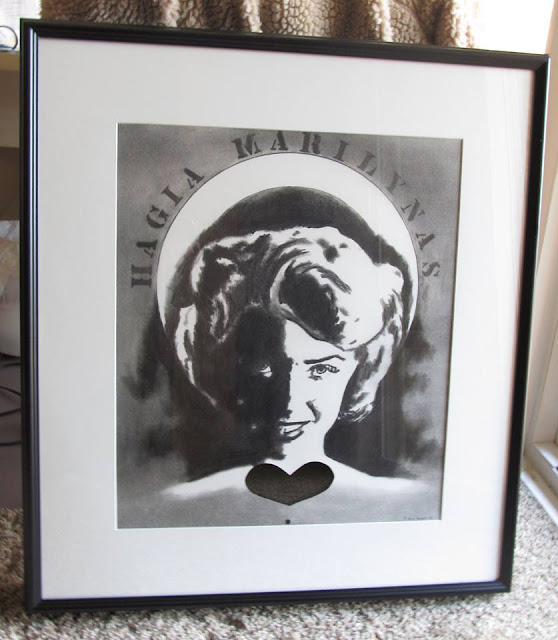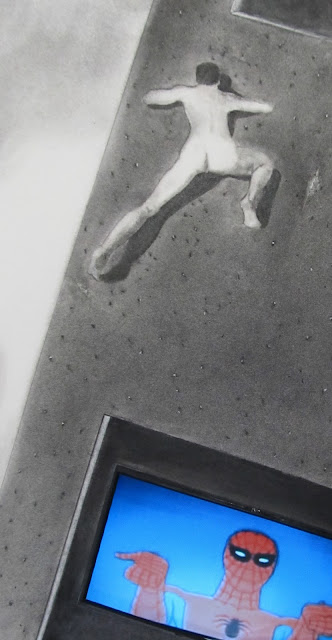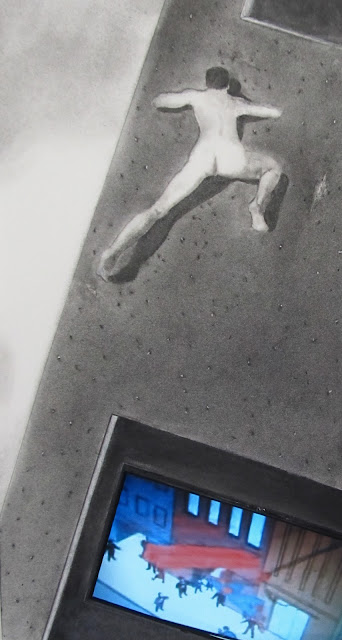AE:
Right, I try not to convey simple emotions. I mean, it’s not about just love, and
anger. I try to make them a little bit
more complex, because I think that’s how our everyday life is, not just black
and white. In the titles of my work I try
to convey that. Well, that one right
there (points to painting), it’s called You
Will Get a Reaction. So it is about
being annoyed. I mean it’s about like,
you’re gonna be a bitch, talk before you think?
Well, you’re gonna get a reaction, kind of thing. So it is a complex emotion, you know, I –
JP: That’s not that complex.
AE: (laughs) I mean,
it’s just not about being angry, it’s about all that entails. So, when a viewer asks me, what did you try
to accomplish with that, I try not to give the whole story. And that’s part of my [artists’] statement –
it’s my story, but it’s also your story.
JP: Your titles are suggestive. So there’s also the question whether I’m
letting the meanings be suggested by the titles. This new painting, What You Keep to Yourself, is very moving I think, it has great
depth. You feel that it’s saying something
but emotions are not translatable into propositions, they’re feelings. So what –
AE: That’s kind of what I wanted to convey.
I obviously had a very clear emotion in mind
when I painted it.
But I don’t want the
viewer to know the exact detail of it because I don’t want to tell the whole
story.
When someone looks at it I want
them to form their own story about it.
It’s
called
What You Keep to Yourself,
well I want them to take a hint out of that, if they want to.
If not, I want them to look at it and form
their own story about it.
JP: Well, “What You
Keep to Yourself” suggests repression, and emotion being kept under the
surface.
AE: Right, when I
painted that – it’s a little bit about being annoyed by, you know, about things
not being said. And –
JP: Oh, it’s not you, it’s someone else who’s keeping things
–
AE: Yeah, yeah. That’s how it was, that’s how it was,
although I will never say that –
JP: Would it be unfair
to see a general theme of annoyance in your paintings?
AE: No. (laughs)
No. (laughs) No, that’s just coincidence I think, from
those two. No, and it’s not the same
person. (laughs) No, no, no, no, no. No, I think I try to mix positive and –
JP: It’s just coincidence.
AE: Yes, it’s a coincidence of those two paintings. And I think this is not only about annoyance
but also about a little bit of mystery.
It’s not all negative I think.
JP: But a sense of frustration at someone else’s lack of
openness.
AE: Exactly. That’s what it was
JP: Getting back to the question of color. To what extent are you conveying emotion – in
other words, transmitting your emotion to the viewer – and to what extent are
you inducing emotion, which is to say, color causes emotions in people, even if the artist doesn’t feel them. If you come up to an Yves Klein painting,
there’s this tremendous shock of blue, it does something to you almost
physiologically, but whether he’s having that emotion or not is unclear. Now, he’s a less –
AE: No, everything I
paint is based on something that I feel.
And I translate it into color the way I feel it. Whether the viewer sees it that way or not – it’s
fun for me to see that. It’s almost a
game, when I exhibit my work and see their reactions or interpretation of it –
whether it’s similar to or different from what I felt when I painted it. But everything I paint is based on how I feel
it.
JP: Let’s talk about
the technical aspect of what you’ve done here.
AE: I always paint on
boards instead of canvas. I think it
reflects the color better than canvas, which absorbs the color. I start with a white gesso surface, and I do
a lot of overlaying. I do layer over
layer of color until I achieve what I want.
So I do start with an idea – it never ends up being what I started with,
but I do have the colors very much in mind when I start.
JP: You know where you’re going.
AE: Yes. I don’t sketch anything, I just have it in my
mind and I start from there. I usually
have a basic composition of colors when I start, like big fields, to guide me
through the overall composition if I’m going to do thirds, or a Z, or just any basic
artistic composition – and then I start playing around, and it becomes a moving
target. At the end I may add a little
bit, you know, like add an unexpected color.
But that is just mostly from a composition standpoint, that’s not even
emotional.
JP: You start with
emotion and gradually you’re gaining distance, you’re creating an object.
AE: Yeah, exactly
JP: You grew up in
Mexico.
AE: Yes, in Mexico
City.
JP: What were your parents?
AE: I really only lived with my mom, who was a
journalist. We lived in Mexico City our whole
life until I moved here 14 years ago.
JP: Were you always interested in art?
AE: I’ve always painted on the side, I just never had the
time, I was raising kids, I was married, I was doing other things. I never really took it full time until my
husband died four years ago. I started
doing it almost as therapy. At the
beginning I didn’t think of it as a second career, but it just started taking
over. Before I’d never done
abstracts. I’d done oil and figure
painting and a lot of silk painting. But
when I thought about taking painting back I wanted to do abstract because I
thought it would be a lot more liberating and creative. I wanted the freedom that comes with abstract
painting.
JP: And you associate it with that period after your
husband’s death.
AE: That’s why I did
the abstract work, because I was looking for healing. That was a period of healing in my life, so I
wanted this to be part of it.
JP: “Healing” is one of those words that’s used too easily
sometimes. After someone dies like that
there’s more than healing to be expressed.
AE: Yeah. Yes. I
also didn’t want my work to be – Well, and I didn’t start painting right after
he died, I think I spent a year with Netflix (laughs) and then I started
painting. But when I was ready to paint
I didn’t want it to be about grieving and mourning, and darks and blacks, no, I
didn’t want that. I wanted it to be more
about how I was reinventing myself. You
know, after the loss -- then what? Then
I had to reinvent myself, and all this process that comes into finding yourself
again and redefining what you’re going to be in life. So I didn’t want it to be this sad, dark – I
didn’t want that, and I don’t think my paintings reflect that at all. I wanted it to be more of the process of
empowerment and liberation and all those kind of things that would come in
afterwards trying to go back into being this new person that I had to be.
JP: You’ve talked
about Rothko, his influence. Who else do
you think about?
AE: Well, one painter
I’ve always admired is Van Gogh, just because of the bold use of color, which
has nothing to do with my style. Rothko
and Clyfford Still just attract me – and I wish I would one day be able to do
paintings as large as they do because I think the large scale is so – is
hypnotizing, the way it involves you.
And that’s one of the things I like about painting large scale, you allow
the color to involve you, you get immersed in it. And more and more I do larger paintings
because of that. So that’s the beauty of
the large colorful paintings.
JP: Alexander
Melamid, a Russian-American artist, talks about how confusing, or rather
confused, art and the role of the artist are now. “There’s a crisis in art,” he says. “We believed ten years ago, twenty years ago, that we knew the
secret. Now we have lost this belief. We are a minority with no power and no
belief, no faith. I feel myself, as an artist and as a citizen, just totally
obsolete... Okay, it can be done this way or that way or this way, or in
splashes or smoothly, but why? What the hell is it about?” What is it about?
AE: Well, I don’t think the role of the artist is
obsolete, but I do think there is a bigger disconnection now between the viewer
and the artist, and I don’t think that is a good place to be. I think the viewer and the artist need to be
closer. When the viewer doesn’t
understand the artist, that’s not a good place to be. And part of this confusion I think started
when people discovered that shock and irony sells. A lot of things have been put into the mix of
art that don’t really belong there. It’s
perfectly okay to make art that’s ironic and shocking and that’s all good but
when the main purpose of it is not artistic, when there’s no artistic value – whatever
concept of aesthetics you have – then it belongs somewhere else. It may be a social manifestation, it may be a
cultural manifestation, it may be crap.
I think there’s a lot of confusion as to what really is art. So I think that’s where it is.
JP: If
you open up Art in America, there’s no painting in it. The only painting is in some of the ads. And yet a gallery like this one is mostly
painting. Is it retro? Is it holding on to something emotionally
satisfying or decorative that doesn’t have intense cultural significance
anymore?
AE: Exactly, you may argue that Abstract
Expressionism was a movement of the ‘40s, the ‘50s, it’s seventy years old or
sixty years old – what am I doing, you know?
But I do think beauty, and artistic technical quality is still something
that has value, that needs to stay
there. I think there’s a lot of crap
that will shed its way out eventually.
Because right now it’s a novelty.
And I want to think that the way I am doing this abstract expressionism
is an evolution, not just a reiteration of what’s been done.
JP: The
challenge is to do something new that’s also still painting.
AE: Right. And, again, I believe in beauty. (laughs)













